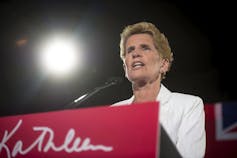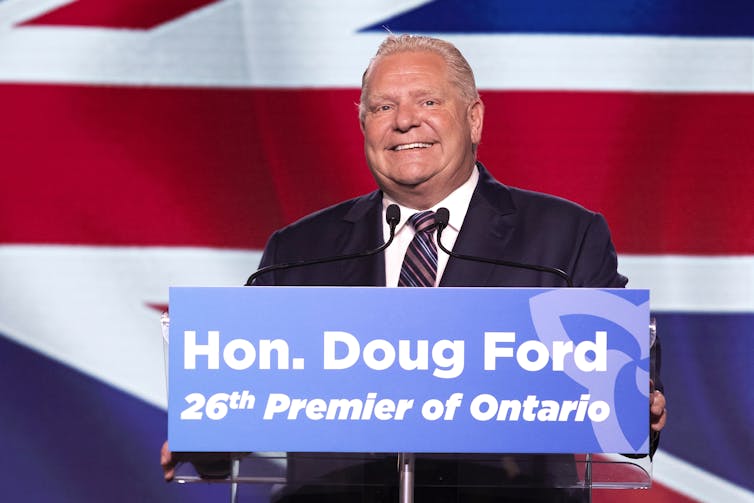
The last two elections have not been kind to the Ontario Liberals, constituting the party’s worst electoral performances since 1943.
This string of defeats has produced soul-searching among partisans and political pundits that tends to ensue when a major party loses power. Yet this time, there’s also an atmosphere of existential dread.
With Doug Ford’s Conservatives comfortably in power alongside an opposition NDP with 31 seats compared to the Liberals’ eight, many have predicted the Ontario Liberals are poised for further decline into a minor party that will never form a government again — or perhaps fade away completely.
These predictions are overstated. They overestimate the extent of Liberal weakness and fail to take into the account the nuances of Ontario’s unique party system.
The fact is, unlike the situation in most provinces — where two parties almost always dominate — Ontario has managed to sustain unique and dynamic competition among the Conservatives, Liberals and NDP.
NDP’s influence
While the NDP has most often placed third in Ontario elections, its ebbs and flows in terms of popularity have meant both the PCs and Liberals have on occasion been reduced to a small number of seats in the provincial legislature.
While this usually meant periods of weakness for both parties, they’ve always eventually returned to power. Even if the Liberals are in momentary decline, that doesn’t rule out an eventual return to power.
Popular support for the Liberals has clearly declined, but an exclusive focus on the seat counts of the last two elections overlooks ground-level conditions and over-emphasizes the extent of the reduction.

The party’s performance in 2018 — in which it won only seven seats with 19 per cent of the popular vote — is best regarded as a routine, quasi-cyclical “change” election aimed at an unpopular incumbent, Kathleen Wynne.
While devastating for the party, it’s difficult to extrapolate long-term trends from that election result. Instead, the 2022 election — when the party won eight seats with 23.6 per cent of the vote — is more helpful.
The Liberals failed to recapture what they lost in 2018, but the bigger picture shows this isn’t particularly noteworthy nor damning for the party.
Popular Conservative government
First, at a time of widespread voter apathy, the Liberals faced a fairly popular incumbent Conservative government that was expected to win.
There was no widespread desire for change among the public to benefit the Liberals. The Conservatives won more seats and also held onto the voters they’d extracted from the Liberals in 2018.
Second, there is little evidence that the New Democrats, as the other opposition party, were in a stronger or more popular position than the Liberals.
Although the NDP won more seats, they obtained a slightly smaller share of the popular vote — 23.4 per cent compared to 23.6 per cent for the Liberals. This disparity, therefore, is for the most part due to the majoritarian electoral system that rewarded the New Democrats for having a more concentrated voter base.
Seen from this perspective, the 2022 results appear to be more conventional. Rather than demonstrating a clear Liberal decline, last year’s outcome was instead the result of a popular government that competed against a divided opposition.
With a Conservative return to power, the Liberals have simply shifted to another stage of the type of cyclical dynamic that characterizes Ontario party politics.

Ballots cast for all three parties
Since the Second World War, the Liberals, Conservatives and NDP each reliably won at least 15 per cent of the popular vote.
More interesting is the fact that, although disproportionately benefiting the Conservatives and Liberals, the order has shifted at times. The Conservatives, for example, had distant third-place finishes throughout the final five years of the 1980s.
At the same time, there is historic precedent for the recent string of results. Throughout periods of PC government, the Liberals and NDP have been roughly tied in both seat count and their share of the popular vote.
This was the norm throughout the 1940s and 1970s, including the 1971 and 1977 elections, when the Liberals won only one more seat than the New Democrats.
While this pattern declined with a period of NDP weakness throughout the 2000s, the recent success of the Conservatives may indicate the trend is set to return. Should the PCs remain popular, the Liberals and NDP would likely stay tied in support.
This Ontario electoral dynamic challenges much of the conventional wisdom surrounding majoritarian electoral systems.
It’s commonly held that elections held under the first-past-the-post system will eventually produce competition between two large parties, and this applies to most of the provinces.
Read more: Canada's first-past-the-post electoral system highlights once again the need for reform
A large centre-right party (like Alberta’s United Conservative Party) competes for office against an equally large centre-left party (most often represented by either the Liberals or NDP).

In the western provinces, the Liberals have declined as a rival centrist alternative. In British Columbia, for example, the provincial Liberal party is comprised of a coalition of federal Liberals and Conservatives to run against the left-leaning New Democrats.
Liberal consistency
Why Ontario is so distinct on this front isn’t entirely clear.
Maybe it’s because rather than having a province-wide three-party system, Ontario is comprised of a number of local two-party systems: regions where Liberals compete against the PCs, Liberals compete against the NDP and the NDP competes against the PCs.
For example, Liberals and Conservatives compete alongside a weak NDP in a number of suburban Toronto ridings. In downtown Toronto, however, the PCs almost always finish third place behind the Liberals and the NDP.
In other parts of Ontario, like Windsor and northern Ontario, strong New Democrats compete against PC challengers.
Ontario’s political culture is also characterized by a shifting and powerful political centre.
Doug Ford’s Conservatives had to tone down their populist roots in favour of a more moderate and pragmatic conservatism to hold onto power.
Read more: What Doug Ford's shift to the centre says about the longevity of populism
The NDP, similarly, has attempted to appeal to centrist voters with their organized labour and activist roots.
But the Liberals have been consistent with their slightly left-leaning centrism that pledges competent and effective economic governance and pragmatic progressive policies.
Regardless of Ford’s win in 2022, Ontario voters change their minds quickly. His government’s ambitious development plans in housing and transportation have brought scores of detractors.
Ongoing Greenbelt scandals evoke memories of similar corruption scandals that brought down the Wynne government.
That means there’s still a path forward for the Liberal party that will enable it to regain ground back from their perpetual competitors — and kick-start Ontario’s distinct three-party cycle anew.
Sam Routley does not work for, consult, own shares in or receive funding from any company or organization that would benefit from this article, and has disclosed no relevant affiliations beyond their academic appointment.
This article was originally published on The Conversation. Read the original article.







